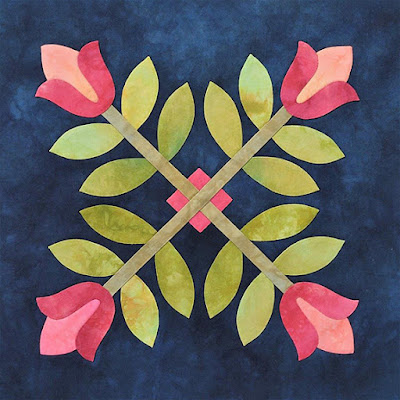American Stars #11 Keepsake Star by Becky Brown
Keepsake Star is an original design for the Sedgwicks and the Freemans of Massachusetts. The Sedgwicks were another English family who came to America in the mid-17th-century "Great Migration" of Puritans looking for freedom of religion.
https://www.masshist.org/database/548
Sedgwicks left voluminous files in the Massachusetts Historical Society plus
many portraits and this keepsake, a chain of gold beads donated in 1884.
The jewelry's donor was William Minot whose late wife Katherine Sedgwick Minot (1820-1880) had inherited the beads from her aunt Catherine Maria Sedgwick. After losing some, he had the remaining beads refashioned from a necklace into a bracelet.
Minot may have asked the jeweler to engrave the name of the original owner
of the necklace. "Mumbet" is on the clasp.
Catherine Maria inherited the beads from Elizabeth Freeman, whom she called Mumbet. Elizabeth, a freed slave, was essentially Catherine's foster mother.
Massachusetts Historical Society
Elizabeth Freeman (c. 1744-1829) in 1811, wearing her beads.
Miniature on ivory by Catherine Maria's sister-in-law,
amateur artist Susan Anne Livingston Ridley Sedgwick.
Both Catherine Maria and Susan Sedgwick were published authors. As one of our contemporary Sedgwicks, John, author of a family biography, told N.P.R. about family keepsakes in 2007:
"[Sedgwicks] wrote everything down. They wrote to each other. They kept journals. They wrote books. Just prolific and brilliant writers."
And they kept their papers. The Sedgwick collection is one of the largest in the Massachusetts Historical Society. John Sedgwick used those papers to write
In My Blood: Six Generations of Madness and Desire in an American Family, his perspective on hereditary bipolar disorder.
Pamela Dwight Sedgwick (1753-1807)
From The Republican Court or American Society
in the Days of Washington, 1855
Pamela was a popular English novel for whom many girls were named.
This portrait seems a romanticized version of the painting below.
A "New England matron...conspicuous for a charming face, and an air and manner of singular refinement and grace,” according to a man who met her at Martha Washington's first Presidential reception. Pamela---Catherine Maria's mother---was unfortunately afflicted with chronic depression.
"My mother may have had a constitutional tendency to insanity....the terrible weight of domestic cares will sufficiently account for her mental illness without supposing a cerebral tendency which her descendants may have inherited....Mumbet was the only person who could tranquillize my mother when her mind was disordered...." Catherine Maria Sedgwick
Domestic cares? Pamela gave birth 10 times (chronic postpartum depression?). Seven children lived to adulthood. Her husband was rarely at home serving in the Washington administration and later politics as Senator from Massachusetts.
Portrait of Catherine Maria and Pamela by Joseph Steward
Perhaps in the collection of Bedwell House
Keepsake Star by Denniele Bohannon
The family of a prominent lawyer had many servants. Elizabeth Freeman was the housekeeper, born into slavery in colonial New York. When Hannah Hogeboom married John Ashley, enslaved Bett and her sister were sent with her to Sheffield, Massachusetts.
Ashley house is now a historic house museum in Sheffield.
Bett often told Catherine Maria about the Ashleys. He was "the most benign of men;" Hannah Hogeboom Ashley was "a shrew, untamable."
Bett had four children, at least one of whom lived with her at the Ashleys. During the Revolution Bett heard talk of independence and freedom, deducing she was entitled to both. She contacted a lawyer, Theodore Sedgwick.
Events as Catharine Maria recalled them.
Yale University Library
Theodore Sedgwick (1746-1813) by John Trumball
Bett made sense to Sedgwick who perhaps was looking for just such a case. He and Tapping Reeve sued Ashley for the freedom of Bett and a fellow slave. In 1781, the court in Great Barrington found for
Brom and Bett v. J. Ashley Esq., freeing the two and awarding them 30 shillings in damages. Bett took the legal name Elizabeth Freeman and went to work as a paid servant in the Sedgwick home where the children called her MammaBet or Mumbet.
When Catherine was about 17 her mother died, as she recalled in a letter to a young relative:
Authors today, having read the Sedgwick papers, tell us the terribly depressed Pamela, in and out of asylums, may have poisoned herself.
America boasted few women novelists in 1827
Catherine Maria became a popular and prolific author developing an American perspective on novels and historical fiction. She also wrote magazine sketches, using memories of Mumbet. In March, 1846 she published one of the first nostalgic articles about quiltmaking "The Patch-Work Quilt" in
The Columbian Lady’s and Gentleman’s Magazine, in which the narrator visits an older Black woman who had been a servant in her home for decades.
The older woman, called Lilly here, shows:"What is called a beggar's-patch-work, formed of hexagonal bits of calico and silk [with] a bit of your mother's wedding gown....Lilly produced it from a store of quilts which she has been in her whole life amassing....they are story-books-family legends."
Example of Beggar's-Patch-work
A few years later Catherine told the story of Mumbet using her name in the sketch "Slavery in New England" in the British Bentley's Miscellany Volume 34, 1853. British traveler and abolitionist Harriet Martineau, who'd met the Sedgwicks in Massachusetts, had earlier told her own version of Mum Bet's tale in her 1838 book Retrospect of Western Travel. (See links to Catherine Maria's writing below.)
Keepsake Star by Jeanne Arnieri
The Block
Keepsake Star is based on BlockBase #1249, a rather
modernistic star designed for the little magazine
Aunt Kate's Quilting Bee in the 1960s.
Additional diagonal seams make it more complex with no Y seams.
Print the pattern on an 8-1/2" x 11" sheet. Note the square inch for scale.
Later Generations
Elizabeth Freeman's children were probably fathered by Jacob "Jack" Burghardt, also enslaved in the Ashley family. Othello Burghardt (1789-1882) may have been their son, born when Elizabeth was in her forties. His grandson was another American Star William Edward Burghardt Du Bois, famous as writer and activist W.E.B. Du Bois, a founder of the N.A.A.C.P.
William Edward Burghardt Du Bois (1868-1963)
photographed in 1946 by Carl Van Vechten who
often used textiles and quilts for backdrops.
The Sedgwick family has been wealthy, creative and industrious for generations, resulting in several famous and once-famous members. There have been lawyers aplenty and published authors and many women who married well (and others....)
Sarah Price Ashburner Sedgwick Darwin (1839-1902)
Sarah Sedgwick married Charles Darwin's eldest son William and moved to England.
Theodore Sedgwick III (1811-1859)
Brady Studios
Her father Theodore Sedgwick III, Pamela Dwight Sedgwick's grandson (1811-1859) was president of the American Crystal Palace Association. He supervised the extraordinary building for America's first international exposition in 1852.
 |
Avery Library Columbia University
New York's Crystal Palace by Victor Provost |
During the Civil War several Sedgwicks joined the Union Army. Sarah Darwin's nephew Arthur of the 20th Massachusetts Volunteers survived Libbey Prison. Her brother William Dwight Sedgwick of the 2nd Massachusetts Volunteers was killed at the Battle of Antietam in 1862.
Major General John Sedgwick (1813-1864)
His uncle John Sedgwick was the highest-ranking Union casualty, killed at Spotsylvania Courthouse. Sedgwick County, Kansas is named for him. Those of us who have spent time in Wichita are well aware of the over-confident General's last words: "They couldn't hit an elephant at this distance."
Edith Minturn Sedgwick (1943-1971)
In our own time there are actresses: Edie Sedgwick died of a drug overdose in Andy Warhol's orbit
Kyra Minturn Sedgwick (b 1965) with husband Kevin Bacon
And once we get around to Kevin Bacon in the chain of links it's time to quit.
A dozen Keepsake Stars by Denniele Bohannon
Photoshopped in an all-over repeat
Further Reading
Read Catherine Maria Sedgwick's "Slavery in New England," an account of Elizabeth Freeman's life in Bentleys Miscellany, 1853, page 417.
Mary Kelley,
The Power of Her Sympathy: The Autobiography and Journal of Catharine Maria Sedgwick, 1993.
John Sedgwick, In My Blood: Six Generations of Madness and Desire in an American Family. Preview:
The town of Sheffield is raising funds to install a 7-foot bronze statue of Elizabeth Freeman by Brian Hanlon.

Harriet Martineau's 1838 account of Elizabeth Freeman.















































%20The%20Return%20to%20Fredericksburg%20After%20the%20Battle%20at%20gettyburgnatlpark.jpg)






























